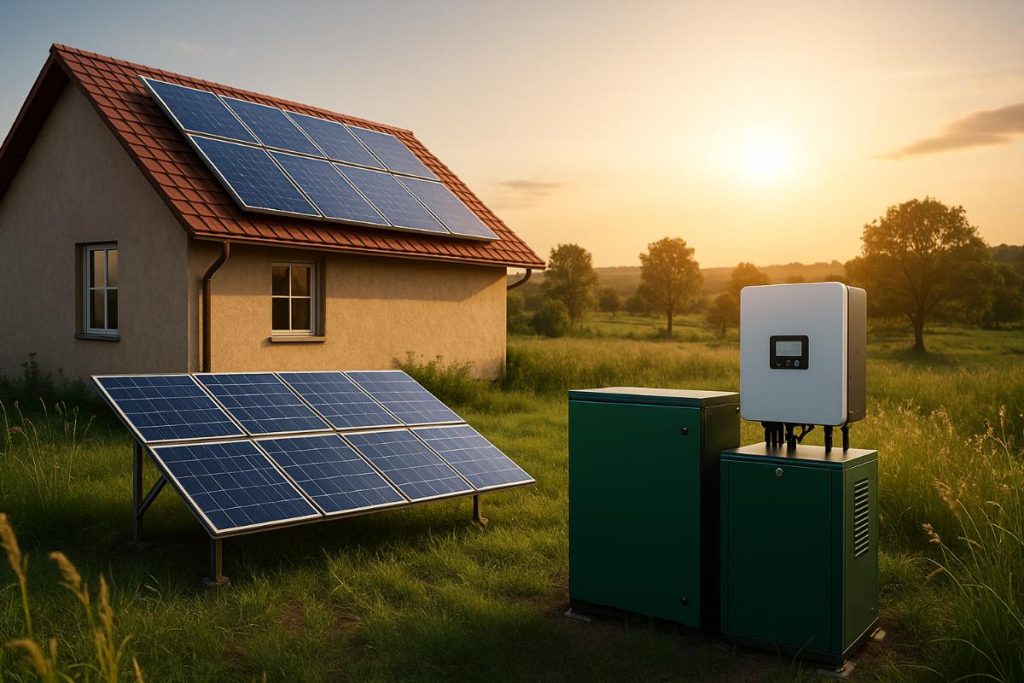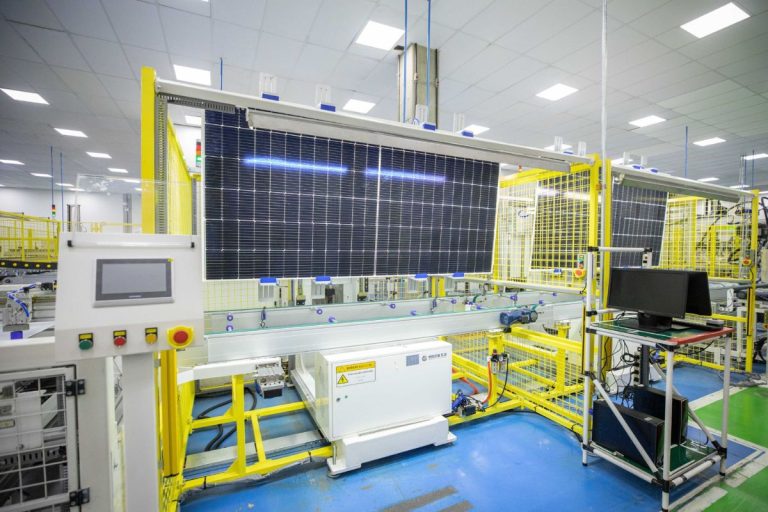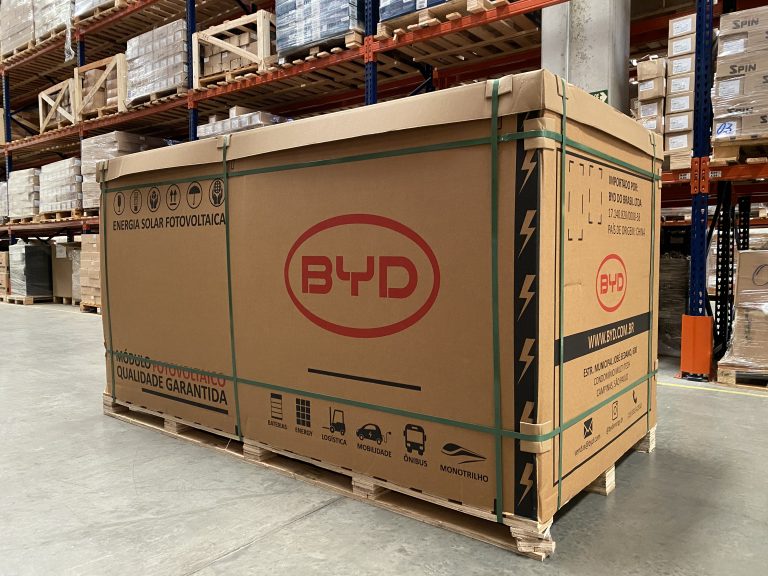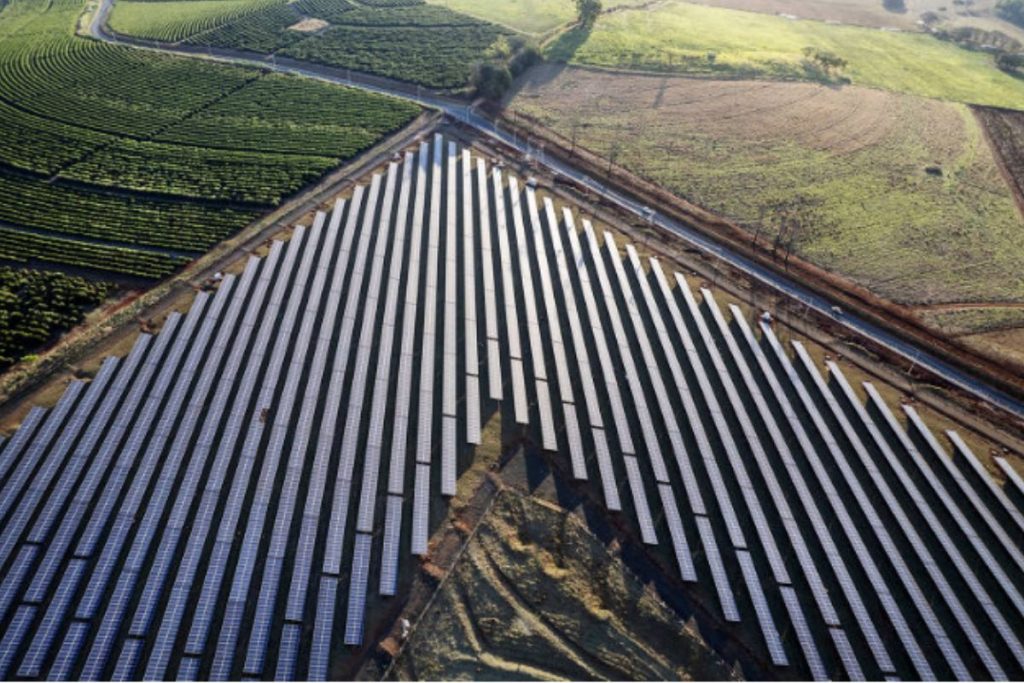Have you ever thought about producing and consuming your own energy without having to rely on the public electricity grid? A off-grid solar system makes this possible. This solution makes it possible to generate electricity from sunlight and store it in batteries for continuous use, even at night or on cloudy days. no connection to the utility.
Ideal for remote areas, rural properties or those looking for total energy autonomy, the off-grid system guarantees independence, security and long-term savings. In this comprehensive guide, you'll get a clear understanding of how it works, its main components, advantages, disadvantages and real applications. At the end, we'll show you how BYD can help you achieve energy freedom with cutting-edge technology.
Ready to disconnect from your electricity bill? Then read on.
What is an off-grid solar system?
One off-grid solar system (also called an isolated or autonomous solar system) is a photovoltaic system capable of operating totally independent from the public electricity grid. Instead of connecting to the utility, all the energy generated by the solar panels is consumed on site or stored in batteries for later use. This means that a property with an off-grid system does not receive power from the external networkIt supports itself with the clean electricity it produces and stores, obtaining energy self-sufficiency. In other words, even if there is a power outage in the area, a well-dimensioned off-grid system will continue to power equipment and illuminate the place, because does not depend on the dealership.
This type of system is ideal for where there is no access to the electricity grid (remote farms, ranches, isolated communities) or for those seeking complete independence from the conventional grid. Many consumers opt for the off-grid to avoid interruptions in supply (in areas with frequent outages or blackouts) and to be able to use the grid. getting rid of energy billsThis is because all the electricity they consume comes from their own generation. With the evolution of battery technologies and cost reductions, off-grid systems are becoming increasingly viable and popular. solar batteries stayed about Cheapest 90% in the last 15 years, increasing interest in this solution in the Brazilian market.
Difference between off-grid and on-grid systems: the main distinction is the connection (or not) to the electricity grid. A on-grid is connected to the public grid and can exchange energy with the utility (surplus injection and use of the grid as a "virtual battery"), while the off-grid operates in a 100% independentThe on-grid system uses a battery bank to store the surplus generated during the day. In this way, the on-grid depends on the grid to work (even switching off in the event of a blackout for system security), while the off-grid depends on the grid to work. works even during blackoutsbecause it doesn't need external infrastructure. There is also hybrid systemThis combines the two modes, remaining connected to the grid and also using backup batteries, offering autonomy even during power outages, but being able to consume from the grid when necessary (a very interesting intermediate option).
It's worth noting that, contrary to what some may think, having an off-grid solar system is completely legal and permitted in Brazil. Because it is an isolated system that does not inject energy into the public grid, it does not require approval with the dealership. A National Electric Energy Agency (ANEEL) already recognizes the so-called zero grid (without connection to the grid) and defines that small isolated systems do not need a permit, although it is recommended to notify the local distributor in larger projects, for safety reasons.
In other words, you you can install an off-grid system on your property, whether urban or rural, as long as it meets the technical safety requirements. There is no ban - on the contrary, the regulatory bodies see isolated systems as a valid alternative for bringing energy to places that are difficult to access.
How does an off-grid solar system work?
Solar panels installed on the roof capture sunlight and convert it into electricity to supply off-grid systems.
The operation of an off-grid system is based on the same photovoltaic capture of conventional systems, with the difference that the surplus energy is stored locally instead of being sent to the network. See the main components and stages of operation:
Solar panels (photovoltaic modules)
They are responsible for capturing solar radiation and converting it into direct current (DC) electricity. They should be installed in a place with good insolation (such as a roof or open ground) and properly oriented to maximize generation.
Charge controller
Device that regulates the flow of energy from the solar panels to the batteries. It prevents overcharging (when the panels generate more than the battery can handle) and excessive discharge of the batteries, prolonging their useful life. In off-grid systems, the controller (usually a MPPT or PWM) is essential for managing the charge in the batteries efficiently.
Batteries (battery bank)
They are heart of the off-grid system in terms of autonomy. Batteries store the electrical energy generated during the day so that it can be used at night or during cloudy periods. In modern systems, mainly lithium-ion batteries are used, in particular the LiFePO₄ (lithium-iron-phosphate)There are also smaller systems with stationary lead-acid batteries. The capacity of the battery bank defines how many hours the system will be able to supply energy in the absence of sunlight.
Solar inverter off-grid
This is the equipment that converts DC energy (from panels or batteries) into alternating current (AC) compatible with common electrical appliances. In off-grid systems, a inverter charger (hybrid inverter), capable of both converting DC->AC to power the loads, and managing the battery charge (often integrated into the controller).
It ensures that the stored energy is useful for powering household appliances, tools, pumps, etc. and can offer different outputs (such as 127V or 220V, single-phase or three-phase, depending on the needs of the location).
Protection frame and accessories
Just like an on-grid system, an off-grid system has circuit breakers, fuses, SPDs (surge protection devices) and other safety components, integrated in string boxes (DC and AC) to protect the system from overloads, shorts and lightning. The entire installation must comply with technical standards to ensure safe operation.
Auxiliary power supply (optional)
In many larger off-grid projects, it is common to integrate an auxiliary energy source, such as a diesel generator or even a wind turbine. This source serves as backup in prolonged periods of low solar generation (several rainy days in a row, for example) or when consumption exceeds the capacity of the solar + battery system. The off-grid inverter can be programmed to automatically start the generator if the battery charge gets too low, guaranteeing 100% of energy availability. However, with good sizing and rational use, many residential off-grid systems can operate on solar and batteries alone, without needing a generator most of the time.
Stages of operation: During the day, photovoltaic panels convert sunlight into electricity (DC). This energy first supplies the consumption of the equipment switched on at the time (television, fridge, pumps, lighting, etc.). If the panels generate more than the instantaneous demand, the surplus energy charges the batteries via the charge controller. At nightfall or during periods when solar generation is insufficient (cloudy weather or very high loads), the system automatically switches to using the energy stored in the batteries. The inverter converts the output of the batteries into stable alternating voltage, supplying the home or installation as normal. This cycle is repeated daily: during the day the batteries charge (if there is a surplus) and at night they discharge, ensuring a continuous supply. If the batteries reach a low level of charge and there is no sun (a critical situation), the auxiliary generator comes into play (if there is one) or the user must save energy until the sun returns.
In short, the off-grid system captures, stores and supplies energy according to solar availability, completely independently. This autonomy requires the right sizing of panels (to generate enough even in winter), batteries (to supply at night and on sunless days) and intelligent management by the inverter/controller. With the right design, you can have 24-hour power using only sunlight as a source.
Advantages of off-grid photovoltaics
Opting for an off-grid system has a number of advantages, especially in specific scenarios. Some of the main ones are:
Total energy independence
The biggest advantage is not having to rely on the dealership. You produces all the energy it consumesThis makes it immune to blackouts and the instability of the conventional power grid. This is especially valuable for those who live in areas with precarious supply or suffer from frequent power outages. Even in urban areas, the independence of the off-grid ensures that essential services continue to function in emergencies (for example, keeping fridges, security systems and medical equipment operational during a blackout). In October 2024, for example, a storm left 2.6 million consumers without electricity in São Paulo, causing more than R$1.6 billion in commercial losses. Experts have pointed out that solar systems with batteries are a viable alternative for guaranteeing energy in these situations, avoiding losses and inconvenience. In other words, having a system with storage protects the user from unforeseen events on the public grid.
Access to energy in remote locations
Off-grid systems make it possible to bring electricity to isolated and rural regions where the conventional network cannot reach or would be extremely expensive to implement. This includes communities in large rural areas, farms, mountain huts, forest bases or even mobile installations (such as boats and motorhomes). Globally, off-grid solar energy has been the solution of choice to offer electricity to the population without access: it is estimated that more than 560 million people will already be served by off-grid solar solutions by 2023.
In countries like Bangladesh, government programs have installed solar home systems which today provide reliable energy for more than 18.5 million people in rural areasThis is a testament to the transformative power of the off-grid in expanding electricity access.
In Brazil, regions of the Amazon and remote communities can also benefit from this technology to have electricity without waiting for grid extensions that would take years.
Self-sufficiency and security of supply
Unlike the on-grid system, which shuts down in the event of a grid failure, the off-grid system continues to operate on its own. For farmers, for example, this means not losing mechanical milking or irrigation if the utility interrupts the supply.
For small businesses or homes, it means keeping lighting and critical appliances working during disasters. This autonomy brings peace of mindEven in the face of natural disasters or external infrastructure problems, you know you'll have an energy source available.
Many users combine the off-grid with backup generators, but in many cases the solar+battery system itself already meets the needs normally met by diesel generators, reducing dependence on fossil fuels.
In fact, adopting off-grid solar energy can drastically reduce the use of diesel generatorsThis saves fuel and prevents noise and smoke in the environment.
Environmental sustainability
Just like connected systems, an off-grid system uses clean, renewable 100% energy from the sun. By generating your own solar electricity, you stop burning fossil fuels (either in the utility's thermoelectric plant or in private generators) and reduces greenhouse gas emissions.
In areas where previously only diesel or gasoline generators were used, the installation of off-grid solar panels greatly reduces local pollution (less CO₂, particulate matter and noise).
Every kWh generated by the sun means one less kWh generated by polluting sources. In addition, well-planned off-grid projects avoid the construction of long transmission lines in environmentally sensitive areas, minimizing environmental impacts. In short, off-grid contributes to sustainability, combining independence and ecological awareness.
Long-term savings and protection against tariffs
Although the initial investment is higher, an off-grid system can bring financial savings over its lifetime. You get rid of monthly energy billswhich usually increase year on year. Instead of paying the utility company, the off-grid user invests the money in their own system. With solar energy in abundance in Brazil, many places are able to supply practically all their consumption with a photovoltaic system alone, zeroing out their electricity bill.
Those who adopt off-grid in places where the alternative would be a generator end up saving on fuel and generator maintenance. It's worth remembering that the sun's energy is free, so once the system is paid for, the cost per kWh generated becomes very low. This protects against tariff fluctuations and red flags for conventional energy. With the downward trend in the price of solar equipment and batteries, the return on investment is getting faster and faster. Therefore, for appropriate uses, off-grid pays for itself over time and the peace of mind of not having to pay bills.
Disadvantages and challenges of the off-grid system
It's not all flowers: before opting for an isolated system, it's important to know the disadvantages and challenges involved:
Higher initial cost
The off-grid system requires a greater investment than an equivalent on-grid system, mainly because of the batteries. The battery bank usually represents a significant portion of the total cost (in addition to special off-grid inverters, controllers, etc.). The greater the desired autonomy (i.e. the more hours/days of consumption without sun), more batteries will be neededThis makes the project more expensive. For this reason, many low-cost off-grid systems are only sized for small loads or basic use, limiting consumption.
On the other hand, on-grid systems don't need this component and end up having a much lower initial cost for the same generating power. It's important to plan your budget well: a complete residential off-grid system can require tens of thousands of reais in batteries to ensure comfort similar to that of the conventional electricity grid.
Battery maintenance and service life
Unlike solar panels, which have a lifespan of 25+ years with little maintenance, batteries have a more limited lifespan. Lead-acid batteries, for example, last an average of 3 to 5 years before they need to be replaced. Lithium batteries (Li-ion or LFP), on the other hand, last longer, exceeding 10 years or several thousand charge cycles, but will still need to be replaced in the future.
This means that there is a periodic replacement cost in the off-grid system (when the batteries degrade). In addition, it requires monitoring: it is necessary to periodically check the condition of the batteries, the charge level, check connections and ensure adequate ventilation of the bank (especially in lead-acid batteries which can emit gases).
In other words, the maintenance of an off-grid tends to be more complex than that of an on-grid, which basically comes down to cleaning the panels.
Lower energy efficiency
Off-grid systems have some additional energy losses compared to on-grid systems. This is because when storing energy in batteries and then reusing it, there are losses in the charge/discharge cycle (lithium batteries have an efficiency of around 90-95%, and lead batteries around 80-90%). There are also losses in the controllers and inverters.
In a well-dimensioned on-grid system, practically all the energy generated is either consumed or injected into the grid for credit; on the other hand, in the off-grid, if the batteries are full and there is no consumption at the time, the solar surplus is simply discarded (the charge controller switches off the panels so as not to overload the batteries).
Therefore, there is potential waste solar energy at times, especially on sunny days with batteries already charged and low consumption. This reduces overall efficiency and makes it necessary to oversize generation a little to guarantee service in the worst conditions (rainy days), knowing that on the best days there will be energy left over.
Total dependence on the local system
In on-grid, if something fails in the solar system (for example, the inverter stops working), the house simply goes back to consuming from the grid and everything continues as normal until it is repaired. Off-grid, on the other hand, all responsibility for supply rests with the system. If an inverter, controller or other critical component fails, you could be left without power until it is repaired.
Similarly, prolonged periods of bad weather may require energy savings or the use of an auxiliary generator if the system can't cope.
A supply resilience depends on the userIt is important to keep maintenance up to date, monitor performance and eventually rely on a backup (a portable generator, for example) for emergencies. This need for extra management and precautions can be seen as a negative point for those who want total comfort.
Environmental impact of batteries
Although the use of solar energy is environmentally friendly, the storage component has some environmental impacts that deserve attention. Batteries, especially lead-acid batteries, contain heavy and toxic materials (lead, sulphuric acid) that require proper disposal and recycling at the end of their useful life, otherwise they can contaminate soil and water.
Even lithium-ion batteries require resource-intensive industrial processes to manufacture (lithium mining, cobalt, etc.) and must be recycled properly to recover valuable materials and avoid pollution.
In other words, off-grid sustainability depends on conscious battery management after use. Fortunately, there are advances in this area: battery recycling programs are on the rise and technologies such as LFP are much less toxic (they don't use heavy metals such as cadmium or lead, and are more stable).
Even so, from an environmental point of view, a grid-connected system (which uses the grid as "virtual storage") doesn't deal with this challenge. In the off-grid, it is essential to plan the life cycle of the battery bank and choose greener technologies when possible.
Complex design and need for specialized engineering
Designing an efficient off-grid system is not trivial. You need to carry out a detailed survey of consumption (equipment, power, hours of use), take into account local sunshine, calculate the battery capacity required and specify suitable controllers and inverters.
Sizing errors can seriously compromise the systemFor example, underestimating consumption can lead to "dark" nights; overestimating too much can mean spending too much on batteries that will be underused. For example, underestimating consumption can lead to nights "in the dark"; overestimating too much can mean spending too much on batteries that will be underused.
Therefore, the installation of an off-grid system should be carried out under the supervision of experienced solar and electrical professionals to ensure safety and performance. This can represent a higher design and installation cost (and a longer implementation time) compared to more standardized on-grid systems.
The off-grid system therefore offers freedom and autonomy, but takes its toll in terms of investment, care and technical knowledge. When deciding on this option, it is important to weigh up these disadvantages and check whether, in your use case, the benefits outweigh the challenges. Often, solutions hybrids (combining solar, batteries and grid power) can offer the best of both worlds, and are worth considering if you have access to the grid but want backup in case of outages.
Off-grid applications (where it is most useful)
One off-grid solution can be the best (or only) alternative in many scenarios. Here are some examples of typical applications:
Isolated homes and rural properties
Farms, cottages or remote communities that are not connected to the electricity grid benefit directly from off-grid solar systems. In these places, the cost of extending the distribution network is often prohibitive or technically unfeasible, so solar energy with batteries becomes the cheapest and quickest way out.
For example, a farm in a remote area that previously relied on diesel generators can install an off-grid system and supply everything from lighting and basic household appliances to water pumping and electric fences, with much lower operating costs. In addition, the need to constantly transport fuel is eliminated. Autonomy also improves quality of life: reliable lighting, the possibility of refrigerating food and medicines, etc.
Government rural electrification projects in Brazil and around the world have already adopted off-grid solar kits to bring light to previously dark communities, with huge social impacts, including more hours for studying, the development of local businesses and a reduction in the rural exodus.
Telecommunications and monitoring systems in remote locations
Cell phone towers, radio repeaters, radio internet equipment and weather stations are often located in high, isolated places (hilltops, mountain ranges) with no access to the electricity grid.
In these cases, off-grid solar with batteries is widely used to power them continuously. Also applications such as environmental monitoringFor example, sensors in forests, security systems in rural areas and even nautical signs can use small off-grid photovoltaic systems to operate independently for long periods, requiring very little maintenance.
Emergency and critical backup applications
Field hospitals, temporary shelters, support bases in disaster areas or even homes in places with an unstable grid can rely on off-grid (or hybrid) systems to guarantee power for vital equipment.
One example was the use of solar systems with batteries during humanitarian crises on Caribbean islands after hurricanes. While the conventional grid was down for months, schools and clinics were able to operate thanks to off-grid solar containers. At home, some people install off-grid systems just to keep critical equipment running during blackouts (here it would be a "hybrid" use, but in isolated mode when the grid is down).
In the commercial sectorFor example, markets or hotels in places prone to blackouts can use solar batteries to ensure a minimum of operation (emergency lighting, cash registers, etc.), avoiding losses and increasing resilience.
Mobility and use in vehicles or boats
Motorhomes, trailersFor example, medium-sized boats and even remote campsites can adopt off-grid solar systems to supply energy. We often see solar panels on boats to charge the batteries that power on-board equipment, or on trailers providing power for lighting, small refrigerators and 12V appliances.
In these cases, the off-grid system brings independence during journeys, reduces the need for noisy generators and allows you to enjoy comfort even far from civilization.
Combination with other renewable sources
Off-grid solar can also integrate hybrid systems with sources such as small wind turbines or micro-hydroelectric plants. In regions with strong winds or waterways, multiple sources can be installed converging on the same battery bank, ensuring more continuous generation (for example, at night the wind can make up for the lack of sun).
This synergy of renewable sources, combined with storage, forms very interesting isolated microgrids - even capable of serving entire communities with a diversification of sources (solar + wind + batteriesfor example). At night, when the sun doesn't contribute, the wind takes over; in dry periods without water, the sun supplies, and so on.
In remote locations without access to the electricity grid, off-grid solar systems - made up of solar panels, charge controllers and batteries - guarantee autonomous and sustainable energy.
An illustrative case of off-grid application in Brazil is that of riverside communities in the Amazon. Many of these communities are beyond the reach of the conventional electricity grid and relied on noisy generators to get a few hours of light at night. In recent years, projects have installed off-grid solar kits in these locations, including panels, batteries and inverters.
Now, residents have reliable electricity for lighting after dark, have been able to implement refrigeration (for better preservation of food and vaccines) and even small productive activities such as grinding flour or charging cell phones, all without spending on diesel and without pollution. The arrival of off-grid solar energy has transformed the local reality, boosting socio-economic development.
In urban areas, pure off-grid is less common (since where there is a grid available, on-grid or hybrid systems are generally chosen for cost-benefit reasons). However, there are people who, out of a philosophy of life (the quest for total autonomy, life on the grid, etc.), opt for off-grid systems. off-the-grid) or to avoid future charges, they choose to disconnect from the grid and use only solar + batteries.
In such cases, it's important to have a good backup system, because even in big cities a string of rainy days can drain the batteries. For most people, a solution hybridIf you want to use solar energy and batteries on a daily basis, but keep a connection point to the utility for any eventuality, it's the most balanced choice.
In conclusion, the off-grid system finds its best applications where energy independence is not just a convenience, but a necessity. Whether it's to provide basic electricity to those who have never had it, or to ensure the uninterrupted operation of critical services, this technology proves its worth on a daily basis. And with the cheapening of batteries and the democratization of solar energy, the tendency is to see more and more off-grid in use, especially in remote regions or special situations.
Request your BYD Off-Grid Project and disconnect from your electricity bill
As we have seen, the off-grid solar system is the answer for those who need or want to operate independently of the electricity grid. It guarantees total autonomyIt provides energy anywhere and under any circumstances, and represents the union of sustainability with security of supply. On the other hand, it requires a higher initial investment and special care in sizing and maintenance, factors that are offset by the benefits in many scenarios.
If you live in a remote location or suffer from constant blackouts, considering an off-grid system could be the right decision for you. quality of life and energy reliability. Before setting up, seek the help of companies and professionals specializing in isolated solar energy. They will be able to assess your case, calculate the ideal generation and storage capacity, and advise on quality equipment (panels, inverters and long-life batteries). Remember that each off-grid project is unique - adapting to the user's consumption profile and the local sun conditions.
How about taking the next step towards energy independence? A BYD is a global benchmark in solar energy and storage solutions, with high-performance lithium batteries and state-of-the-art hybrid inverters (See our batteries). Consult our experts to set up a tailor-made off-grid system and free yourself from the limitations of the conventional electricity grid.
Secure your off-grid solution now and enjoy clean, reliable energy wherever you are! Get in touch for a customized project and achieve your dream of energy autonomy.








